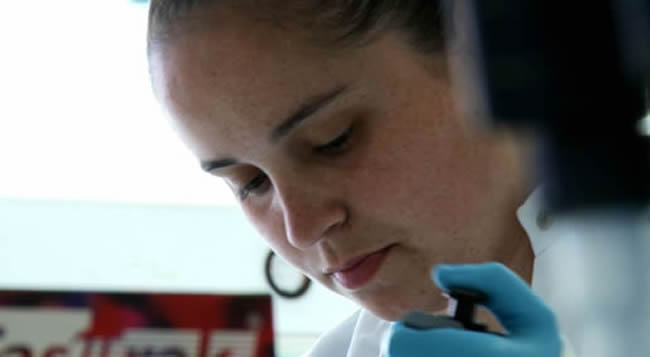Taking a Genetic View of ADHD
- Published20 Sep 2010
- Reviewed24 Feb 2014
- Source Wellcome Trust
Attention deficit hyperactivity disorder (ADHD) is a common mental health problem that severely disrupts people’s lives. It is poorly understood and is often dismissed as bad behaviour or laziness. It has recently been discovered that children with ADHD are more likely to have pieces of their DNA duplicated or missing than other children. Penny Bailey spoke with Anita Thapar about the importance of showing that there is a genetic basis to ADHD, and how this might help us understand its biological causes.
"We know very little about what causes ADHD and how it develops," says Professor Anita Thapar, Clinical Academic Child and Adolescent Psychiatrist at Cardiff University School of Medicine. Indeed, children with ADHD are not always taken seriously, or given public sympathy. ADHD is often seen as an excuse for bad behaviour and laziness, or simply blamed on bad parenting, For many, it is not a 'serious' disorder, even though it affects one to two per cent of children, and is one of the most common reasons for children to use mental health services.
"One of the things I'm really struck by when I see families and children in the clinic is this issue about public perceptions of ADHD, and the media representations of ADHD," says Professor Thapar. "My sincere hope is that, through these scientific findings, the general public and services will take ADHD seriously."
Over the last 15 years, Professor Thapar and colleagues have been building evidence to show that ADHD has genetic links. Now, by looking across the genomes of children with ADHD, they have uncovered direct evidence of a genetic contribution to the disorder as well as intriguing links to autism and schizophrenia.
Genetic clues
ADHD's hallmark symptoms are hyperactivity, inattention and impulsiveness: children are restless and fidget, can't concentrate on schoolwork or TV, and are very impulsive, not waiting their turn, and doing things without thinking. Most children show at least some of these symptoms at times in their development, but for those with ADHD, the symptoms are not only extremely severe, but they are also inappropriate for the age of the child and are present in more than one setting.
The problems accompanying ADHD disrupt both learning at school and relationships with family and friends in childhood. Adults with ADHD are more likely to have difficulties getting or keeping employment, abuse drugs and alcohol, and end up in prison or with a criminal record.
So what do researchers currently understand about the genetic basis of the ADHD?
"We've known for many years that ADHD tends to run in families, so there is likely to be a genetic contribution," says Professor Thapar. "Over a decade ago, we studied identical and non-identical pairs of twins, and showed that ADHD is indeed highly heritable, as people who have close relatives with ADHD are more likely to develop it themselves."
Population studies
Another clue came from a study of 'candidate genes' between 2000 and 2003, funded by the Wellcome Trust. This study looked at a selection of genes affectingthe brain and behaviour in 300 children with ADHD from clinics in England and Wales. They found that a variant in a gene called COMT, which is involved in the breakdown of the brain transmitter dopamine, was linked to antisocial behaviour in those with ADHD.
Furthermore, the children with ADHD were more likely to have a variant that produced a more active version of the COMT enzyme that breaks down dopamine faster in the brain - a finding that has since been replicated by many other groups in different countries.
Searching across the genome
This was important progress, but complex disorders such as ADHD are likely to affect many different genes. In 2007, Professor Thapar and colleagues were awarded funding by the Wellcome Trust to investigate the genomes of children with ADHD, to find out which other regions might be involved in the disorder.
Findings in a paper published in the 'Lancet' in September 2010 confirmed that there are differences in certain parts of the genome between children with and without ADHD. These discrepancies were in copy number variants (CNVs) - pieces of the genome that are duplicated, sometimes many times, or deleted altogether. "These children had double the rate of rare, large CNVs than normal controls," says Professor Thapar.
Another exciting finding was that the CNVs associated with ADHD occur in regions of the genome associated with both autism and schizophrenia. Although these are clinically separate conditions from ADHD - and the study specifically excluded people who might have them - there appears to be a genetic overlap.
"We've known that ADHD and autism share some clinical similarities," says Professor Thapar, "but they've always been regarded as separate conditions. Now that we've found that there is an overlap between regions of the genome that harbour CNVs related to ADHD, and regions implicated in autism and schizophrenia, it brings these neurodevelopmental disorders together. That is important because some people believe ADHD is better viewed as a behavioural problem or social construct rather than a neurodevelopmental disorder that shares biological similarities with autism and schizophrenia."
Also emerging from the study was the finding that the increased rate of CNVs in ADHD was not related to intellectual disability. "A proportion of people with ADHD do have intellectual or learning disabilities, so it could be that the CNVs we found are related to IQ, not to ADHD," she explains. "But we've shown that these CNVs are not just found in people with learning disabilities."
Towards better-tailored treatments
Professor Thapar hopes that this research will stimulate scientific interest in this area. "These aren't the sort of findings that will lead to a test for ADHD," she points out. "We already have that - the best method for diagnosis at present is to ask the right sorts of detailed, careful questions. But this type of research might help us to refine our diagnoses or define meaningful subgroups."
"Most importantly, the results can help us understand the causes and biology of ADHD, which can suggest how it might be treated. At the moment, we only have a limited range of treatments available; but if we can understand what is happening in the brain during the development of ADHD, we might be able to develop more precisely tailored, more effective treatments."
Equally important is the impact such findings can have for families, as parents are often blamed for their children's 'bad behaviour'. "The parents of children with ADHD that I meet in the clinic are heroes," says Professor Thapar. "And they don't get a break - they don't get any sympathy, as there's no visible problem with their child. The affected children struggle with school and rejection by their peers. Now we can show people that these children have a neurodevelopmental disorder with an observable genetic contribution."
"We've come a long way in the last 20 years in our understanding of autism and schizophrenia, such that people hopefully don't encounter the sorts of stigma that they might have in the past. I hope that this will help do the same for children and families with ADHD."
CONTENT PROVIDED BY

Wellcome Trust
Also In Archives
Trending
Popular articles on BrainFacts.org




















